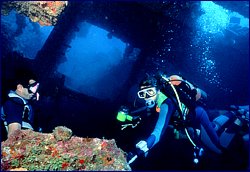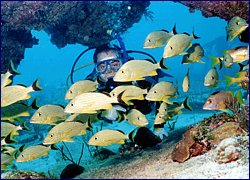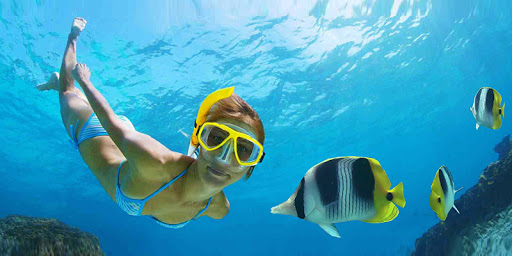Diving & Snorkeling
On the insular platform 
On Cuba’s coral reefs, divers and snorkelers can get up close and personal with thousands of vibrant underwater species, fabulous topography and unusual wrecks. World-class dive sites, equipment and instructors combine to make the Cuban underwater experience one to revisit again and again. Jacques Cousteau thought so, too—when he filmed Cuba, Waters of Destiny.
Cuba’s 30 dive centres provide packages for everyone—from novices to pros. Some also provide certification as well as courses in marine photography, night diving and other interests. Most centres are near hotels and resorts, and have equipment for rent. However, underwater photographers should bring their own camera equipment, silicone and film to ensure they get the shots they need. Cuba also has several recompression chambers.
| Highlights of Cuba’s underwater world: |
Much treasure lies beneath the unpolluted waters of the Cuban archipelago, which offers through-water visibility of 30 to 40 metres. Home to more than 500 varieties of fish, crustaceans, sponges, mollusks and coral, Cuba’s ecosystem is one of the most treasured in the Caribbean. And the wrecks of several 17th- and 18th-century Spanish galleons carrying valuable cargo provide treasure-hunting of a different sort.
Today, CARISUB, [link to this company’s Web site] a Cuban marine archeological organization, charters salvage tours of such sites around Cuba. One well preserved wreck that went down more than 100 years ago near Santiago de Cuba is the 6,800-ton El Cristobal Colon, once the pride of the Spanish navy. The wreck is also home to colourful underwater life that is either attached to the hull or weaves playfully in and out.
Spectacular canyons and caves harbour natural treasures galore. You can see eye to eye with angelfish, blue chromis, squirrelfish, snook, groupers and more. You can gaze in awe at tortoises, sharks, blue marlin and swordfish. Or visit coral gardens that rival any on earth. And take home memories to brag about.
| Main dive sites: |

Los Canarreos Archipelago: Has 56 designated dive sites at Puertosol Colony International Scuba Centre and Cayo Largo del Sur.
Guanahacabibes Peninsula: Access to more than 50 dive sites from María La Gorda International Scuba Centre.
Havana: Has 72 scuba sites available through four international diving centres. Immersion area is more than 100 kilometres long and three kilometres wide. Some 20 kilometres east of thecity lies a coastal belt of white coral sand.
Santa Lucía: An extensive coral reef just off this beach resort has 34 designated dive points and numerous shipwrecks.
Varadero: Has more than 25 diving sites. Especially popular is the Cayo Piedras del Norte underwater park, where old yachts, frigates and planes have been deliberately sunk for recreational exploration.
Playa Girón: The top attraction here is the sheer drop off the island’s underwater platform.
Northern coast of Holguín: More than 20 dive sites are located just off Esmeralda and Guardalavaca beaches.
Ancón Peninsula: This area’s two well defined dive sites are Ancón and Cayo Blanco de Casilda.
Santiago de Cuba: Scuba centres operate out of Baconao Park (Sigua and Bucanero) and Guamá municipality. Site of the Caribbean’s best preserved sunken ship, the Spanish warship Cristóbal Colón.
Cienfuegos: International jet-ski competitions are held here every year, as are occasional speedboat competitions.
Jardines del Rey: In Cayo Coco and Cayo Guillermo, coral reefs offer attractive underwater landscapes.
 29.24°C
29.24°C




